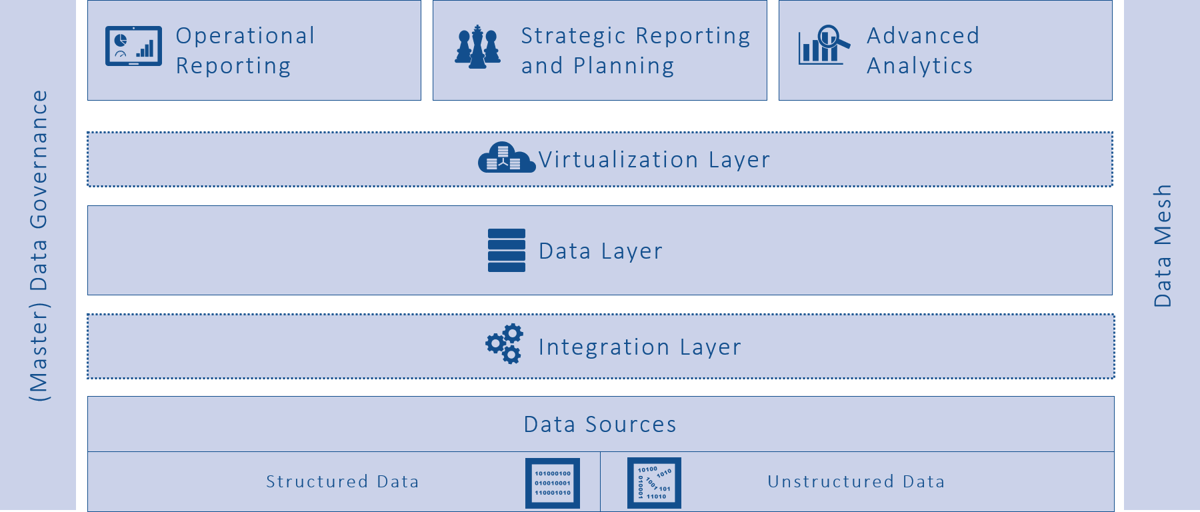Data-based decisions are an important competitive advantage. Today, every company has access to vast amounts of data. But only a few are in a position to actually use the potential inherent in this data profitably for their own business success and for decision-making. The fact that this rarely succeeds is due to various challenges that companies face when dealing with data. These can be clustered into five areas:
-
Governance
-
Employees
-
Processes
-
Costs
-
Organization
Create the foundation for a data-driven approach to business
Challenges in handling data
Challenge #1: Governance
The topic of governance is becoming increasingly important in connection with data due to strict legal regulations. However, companies often lack binding guidelines and standards for topics such as authorizations, access control, collection, storage and destruction of data, security and data protection.
Governance also plays an important role for data consistency and data quality. Companies need appropriate regulations to check and maintain the consistency and quality of their data. Modern approaches to data management, for example, are no longer providing data from a central location in the company and taking responsibility for it. Instead, responsibility is being shifted in the sense of a decentralized architecture to the departments in whose daily business the data is also generated. Such concepts are referred to as data democracy or data mesh.
Challenge #2: Employees
In order to be data-driven, companies must meet the requirements of contemporary data management not only from a technical perspective. Employees must also live the new data culture. Users are increasingly demanding more from data: they want real-time delivery, greater utility, and the ability to make faster adjustments.
Often, however, there is a lack of suitable specialists to lift a company’s treasure of data. In order to keep pace with developments in data management, employees must have suitable skill sets. The constantly changing work environment, the high level of complexity and the associated ever shorter upskilling cycles require a high level of willingness to change on the part of employees. In addition, the number of tools, technologies and development stacks in use is constantly increasing as companies select the best system for the specific use case in each case in accordance with the best-of-breed approach – regardless of the manufacturer.
Challenge #3: Processes
It is by no means the rule that the processes related to data are cleanly defined, mapped on the system side and documented in companies. As far as adjustments and changes to value creation processes and downstream IT processes are concerned, flexibility is often rather low. This is compounded by slow reaction times and a low level of automation and digitization in the processes. Data lifecycle management, which covers the entire lifecycle of data from creation to deletion, is also too rarely in place.
Both the amount and the types of data are constantly increasing. For example, usage data (behavioral) and streaming data (Internet of Things) are emerging from business processes, offering additional potential for analysis and decision-making. Semi-structured and unstructured data should also be evaluated to a greater extent.
Challenge #4: Costs
There are costs associated with collecting, storing, processing, and querying data. Existing systems often prove too expensive for big data applications. Scalability is usually not available at all or only to a limited extent. It is not uncommon for companies to have complex ETL/ELT processes in order to use data for analytical purposes. Redundancies in data storage must be accepted for high performance of relational databases. Data virtualization is not yet too widespread. From a cost perspective, the huge increase in data volume necessitates storage on hyperscalers such as Microsoft Azure, Google Cloud Platform and Amazon Web Services (AWS) or in data lake applications.
Challenge #5: Organization
In order for a company to be data-driven and not have to make decisions based on gut feeling, it needs not only suitable technological solutions but also the right mindset and a true data culture. Ultimately, the entire organization must support the data-driven approach.
However, in reality, there is often little willingness to change, which starts at the C-level. People find it difficult to change their habits. The lack of commitment from employees and management stands in the way of establishing a true data culture.
Data democratization plays an essential role in a company’s competitiveness so that more employees have access to the data that is relevant to them. Data silos make it difficult to work across departments. Employees prefer to stick to old processes and are not prepared to deal with new topics. In addition, there is a lack of training and development processes to empower employees in terms of a data-driven approach.
Answer to data challenges: Business Analytics Platform
The Business Analytics Platform is a holistic framework from IBsolution that solves the most pressing challenges in handling data. It is composed of several layers:
- Data Sources
- Integration Layer
- Data Layer
- Virtualization Layer
- Reporting Layer

Depending on the characteristics of the company, the data landscape can be very heterogeneous. A wide variety of applications exist as data sources – cloud systems, on-premise systems, SAP solutions, non-SAP systems – and the data is available in structured or unstructured form. The integration layer brings the data from the source systems to the data layer, where it is persisted and stored.
Now the data must be made available for the various reporting disciplines (operational reporting, strategic reporting & analytics, advanced analytics). It means a decisive competitive advantage if the different data can be put into context. However, the heterogeneity of data storage makes precisely this step difficult. This is where the Virtualization Layer comes into play. It creates a unified view of the data from the Data Layer by consolidating the data and putting it into a business context.
The layer structure of the Business Analytics Platform is flanked by the topics of data mesh and (master) data governance, which ensure high data quality. Decentralized provision of data in the data layer is the first step toward establishing a data mesh architecture in the company. Organizational Change Management (OCM) should also be an indispensable part of the Business Analytics Platform. OCM ensures that employees accept the changes and establish a new (data) culture in the company.
Features of the Business Analytics Platform
The holistic approach of the Business Analytics Platform takes into account not only technological aspects, but also the organizational structures and the people without whom a data-driven company cannot function. As part of the end-to-end process view, the question of which data can remain in the source system and which is persisted in the data layer must also be clarified.
In addition, the Business Analytics Platform also pursues the goal of high cost efficiency. For example, virtualization is a favorable form of data storage because the data remains where it is created. A lower number of ETL processes has a positive effect on the cost side. The topic of governance is essential simply because of the applicable legal regulations on data protection. Data storage on hyperscalers and data virtualization ensure high scalability.
Who benefits from the Business Analytics Platform?
The Business Analytics Platform has a positive impact throughout the enterprise. Management can make better decisions based on real-time data. It maintains full cost control and has a vital interest in the governance issue, as management is liable for data breaches.
The Business Analytics Platform gives end users access to the data that is relevant to them as easily and cost-effectively as possible. Data democratization and the decentralized architecture of the data mesh are the main contributors to this. The Business Analytics Platform provides users with a comprehensive solution to handle all business requirements and tasks. At the same time, the framework offers a high degree of flexibility for necessary adjustments. High data quality is also ensured and serves as the basis for use cases with artificial intelligence and machine learning.
As the operator of the Business Analytics Platform, IT creates a future-proof and scalable architecture that meets the requirements for a data-driven company. The costs are predictable and manageable. The concept of the Business Analytics Platform is also suitable for heterogeneous IT landscapes. The best-of-breed approach incorporates existing contracts and employee skills.
![IBacademy_Logo_blau[496] IBacademy_Logo_blau[496]](https://www.ibsolution.com/hs-fs/hubfs/IBacademy_Logo_blau%5B496%5D.jpg?width=200&name=IBacademy_Logo_blau%5B496%5D.jpg)




